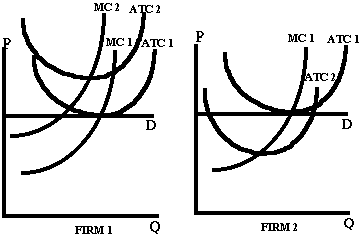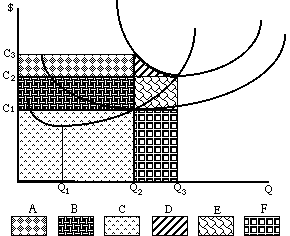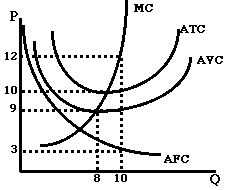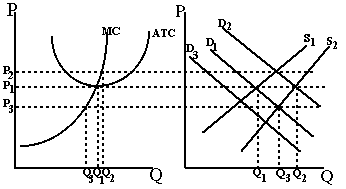- not alter his consumption pattern.
- consume more books and more apples.
- consume fewer books and more apples.
- consume more books and fewer apples.
- consume fewer books and fewer apples.
- the price of a good is closely related to its marginal rather than total utility.
- the price of a good is closely related to its total rather than marginal utility.
- water is a normal good.
- diamonds are an normal good.
- the demand for diamonds is elastic.
Figure 1
- $15
- $20
- $30
- $40
- $50
- 20 slices of pizza.
- 15 slices of pizza.
- 10 slices of pizza.
- 8 slices of pizza.
- 45 slices of pizza.
I. MUx = MU y
II. P x = P y
III. The slope of Budget line = slope of indifference Curve.
IV.Consumption bundle must be on budget constraint.
- I
- I and II
- III
- III and IV
- I and IV
| Table 1 | ||
|---|---|---|
| Gross Utility for Tofu Burgers and Iced Tea | ||
| Quantity | Marginal Utility | Marginal Utility |
| from Tofu Burgers | from Iced Tea | |
| 4 | 60 | 15 |
| 5 | 45 | 11 |
| 6 | 33 | 9 |
| 7 | 27 | 6 |
| 8 | 18 | 5 |
- 4 Tofu Burgers and 11 Iced Teas.
- 6 Tofu Burgers and 5 Iced Teas.
- 5 Tofu Burgers and 8 Iced Teas.
- 8 Tofu Burgers and 3 Iced Teas.
- 7 Tofu Burgers and 6 Iced Teas.
- 7 Tofu Burgers and 6 Iced Teas.
- 8 Tofu Burgers and 3 Iced Teas.
- 6 Tofu Burgers and 9 Iced Teas.
- 8 Tofu Burgers and 7 Iced Teas.
- 6 Tofu Burgers and 7 Iced Teas.
Figure 2
- C and D.
- B and D.
- A and B.
- A and C.
- B and C.
- C and D.
- B and D.
- A and B.
- A and C.
- B and C.
Figure 3
- PN - PS
- PS
- PN - PO
- PN
- PS - PO
- PS - PO, and thus pizza is a normal good.
- PN - PS, and thus pizza is a normal good.
- PS, and thus pizza is an inferior good.
- PN- PS, and thus pizza is an inferior good.
- PN, and thus pizza is a normal good.
- Charlie's indifference curve for Pizza and Soda.
- The compensated budget constraint Charlie would face if we took away income equal to the income effect that results from a decrease in the price of pizza.
- Charlie's original budget constraint.
- The compensated budget constraint Charlie would face if we took away income equal to the substitution effect that results from a decrease in the price of pizza.
- Charlie's ordinary new budget constraint after the price of pizza fell.
- as price rises, for a good such as pizza, more is always purchased.
- as price falls, for a good such as pizza, less is always purchased.
- bundles to the left of PO were available before the price changed but were not chosen.
- The income effect for an inferior good always works in the same direction as the substitution effect.
- The income effect for a normal good always works in the opposite direction as the substitution effect.
Figure 4
- P3 - P1.
- P1 - P2.
- P3 - P2.
- 0.
- P1 + P2.
- area A + area C.
- area A + area B.
- area C + area D.
- area B + area D.
- area F.
- area A.
- area A + area B.
- area C + area D.
- area B.
- area E - area F.
- area A + area C.
- area A + area B.
- area C.
- area B + area D.
- area E + area F.
- the item being taxed has many close substitutes.
- demand or supply is very elastic so that the change in equilibrium quantity due to the tax is large.
- demand or supply is very elastic so that the change in equilibrium quantity due to the tax is small.
- demand or supply is very inelastic so that the change in equilibrium quantity due to the tax is large.
- demand or supply is very inelastic so that the change in equilibrium
quantity due to the tax is small.

Figure 5
- an increase in consumer demand for the product which is an inferior good.
- an increase in the cost of the raw materials used in production of the good.
- an increase in annual insurance premiums paid by the firm.
- a decrease in annual rent paid on the building used by the firm.
- a decrease in the wages of workers in this firm.
- an increase in consumer demand for the product which is an inferior good.
- an increase in the cost of the raw materials used in production of the good.
- an increase in annual insurance premiums paid by the firm.
- a decrease in annual rent paid on the building used by the firm.
- a decrease in the wages of workers in this firm.
- maintain the same level of output.
- increase its output.
- decrease its output.
- shift the curves back to their original positions.
- shift its demand curve up.
- maintain the same level of output.
- increase its output.
- decrease its output.
- shift the curves back to their original positions.
- shift its demand curve up.
Table 2 GROSS GENERALIZATIONS Generalizations Produced Total Cost 0 25.00 1 35.00 2 50.00 3 70.00 4 95.00 5 125.00 6 160.00 7 200.00
- 5 generalizations.
- 4 generalizations.
- 3 generalizations.
- 6 generalizations.
- 7 generalizations.
- between $26.66 and $33.33.
- between $26.66 and $28.57.
- between $160 and $200.
- between $35 and $40.
- between $28.75 and $33.33
- $0.50.
- $0.60.
- $0.40.
- $0.41.
- $0.10.
- $0.51.
- $0.61.
- $0.40.
- $0.41.
- $0.10.
| Table 3 | |
|---|---|
| Data For April Showers Inc. | |
| Umbrellas Produced | Total Cost |
| 0 | 10.00 |
| 1 | 15.00 |
| 2 | 24.00 |
| 3 | 39.00 |
| 4 | 60.00 |
| 5 | 85.00 |
- $39
- $13
- $5
- $10
- $15
- $60
- $39
- $20
- $21
- $15

Figure 6
- areas A + B +D + E.
- areas A + B + C.
- areas D + E + F.
- areas E + F.
- area C.
- areas A + B + D + E.
- areas A + B + C.
- areas D + E + F.
- areas E + F.
- area C.
- areas A + B.
- areas A + B + C.
- areas D + E + F.
- areas E + F.
- area C.
The following information is needed for the next 3 questions: A profit maximizing perfectly competitive firm is observed producing 800 books per day when the market price of books is $15.00. The total cost of producing 800 books per day is $4000.00. The firm's total fixed costs average to $1000.00 per day
- $5.00
- $10.00
- $15.00.
- $100.00
- $4000.00
- $3.75.
- $4.00
- $1.25
- $15.00
- $3000.00
- $3.75
- $4.00
- $1.25.
- $15.00
- $1000.00
| Table 4 | |
|---|---|
| Joe's Utility for Novels per Month | |
| Number of Novels | Total Utility in $ |
| 0 | $0 |
| 1 | $3 |
| 2 | $7 |
| 3 | $12 |
| 4 | $16 |
| 5 | $19 |
| 6 | $21 |
| 7 | $22 |
- Between 3 and 4 books.
- Between 4 and 5 books.
- Between 1 and 2 books.
- Between 2 and 3 books.
- Between 5 and 6 books.
- between $3.80 and $4 per book.
- between $2 and $3 per book.
- between $3 and $4 per book.
- between $4 and $5 per book.
- between $16 and $19 per book.
- as income rises consumers purchase more normal goods.
- as income rises consumers purchase more luxury goods.
- as the price of a good falls it is like getting more income.
- as income falls consmers purchase more inferior goods.
- as we purchase less of any good we experience diminishing marginal utility.
| Table 5 | ||
|---|---|---|
| Fred's Marginal Utility for Brats and Beer | ||
| Quantity | MU of Brat | MU of Beer |
| 1 | 16 | 11 |
| 2 | 14 | 10 |
| 3 | 12 | 9 |
| 4 | 10 | 8 |
| 5 | 8 | 7 |
| 6 | 6 | 6 |
| 7 | 4 | 5 |
| 8 | 2 | 4 |
- 5 brats and 2 beers.
- 2 brats and 8 beers.
- 5 brat and 1 beer.
- 3 brats and 6 beers.
- 4 brats and 4 beers. Answer to Question 38
- 3 brats and 3 beers.
- 2 brats and 4 beers.
- 4 brats and 2 beers.
- 5 brats and 1 beer.
- 1 brat and 5 beers.
- $2.
- $3.
- $4.
- $5.
- $6.
- 6 brats and 3 beers.
- 3 brats and 5 beers.
- 4 brats and 4 beers.
- 4 brats and 5 beers.
- 5 brats and 4 beers.
- there was no change.
- it fell by 1 beer.
- it fell by 2 beers.
- it fell by 3 beers.
- it rose by 1 beer.
Figure 7
- A
- B
- C
- D
- E
- break even.
- operate at a loss
- earn positive profit.
- shut down.
- cover all its costs, fixed and variable.
Figure 8
- produce Q1 because at that level of output price equals marginal cost.
- produce Q2 because at that level of output it covers all variable costs.
- produce Q 3 because at that level of output it covers total costs.
- produce Q 4 because at that level of output it minimizes its average variable cost.
- produce Q 5 because at that level of output price equals marginal cost.
| Table 6 | |
|---|---|
| DATA FOR DODADS INC. | |
| Number of | Dodads produced |
| Workers | Per Hour |
| 1 | 8 |
| 2 | 16 |
| 3 | 23 |
| 4 | 29 |
| 5 | 34 |
| 6 | 38 |
| 7 | 41 |
| 8 | 43 |
| 9 | 44 |
- 3 workers.
- 4 workers
- 5 workers.
- 6 workers.
- 7 workers.
- 3 workers.
- 4 workers
- 5 workers.
- 6 workers.
- 7 workers.

Figure 9
- 30
- 90
- 40
- 100
- 120
- - 20
- 20
- - 70
- 30
- 120

Figure 10
- There is no change in the output for the firm or the industry.
- Price and quantity produced increase for the firm and industry.
- Output increases for the firm but falls for the industry.
- Price decreases for the firm, but increase for the industry.
- Price stays the same for the firm, but quantity decreases.
- An increase in the cost of an input.
- Firms leaving the industry due to the fact that firms were operating at a loss.
- Firms leaving the industry due to the fact that firms were earning positive economic profits.
- Firms entering the industry due to the fact that firms were earning positive economic profits.
- Firms entering the industry due to the fact that firms were operating at a loss.
- The firm and the industry will produce at the same level as before.
- The firm and the industry will produce more at a higher price.
- The firm and the industry will produce less at a lower price.
- The firm will produce at the same level at the original price while the industry will produce more at the original price.
- The firm will produce less at the original price, while the industry will produce more at the original price.